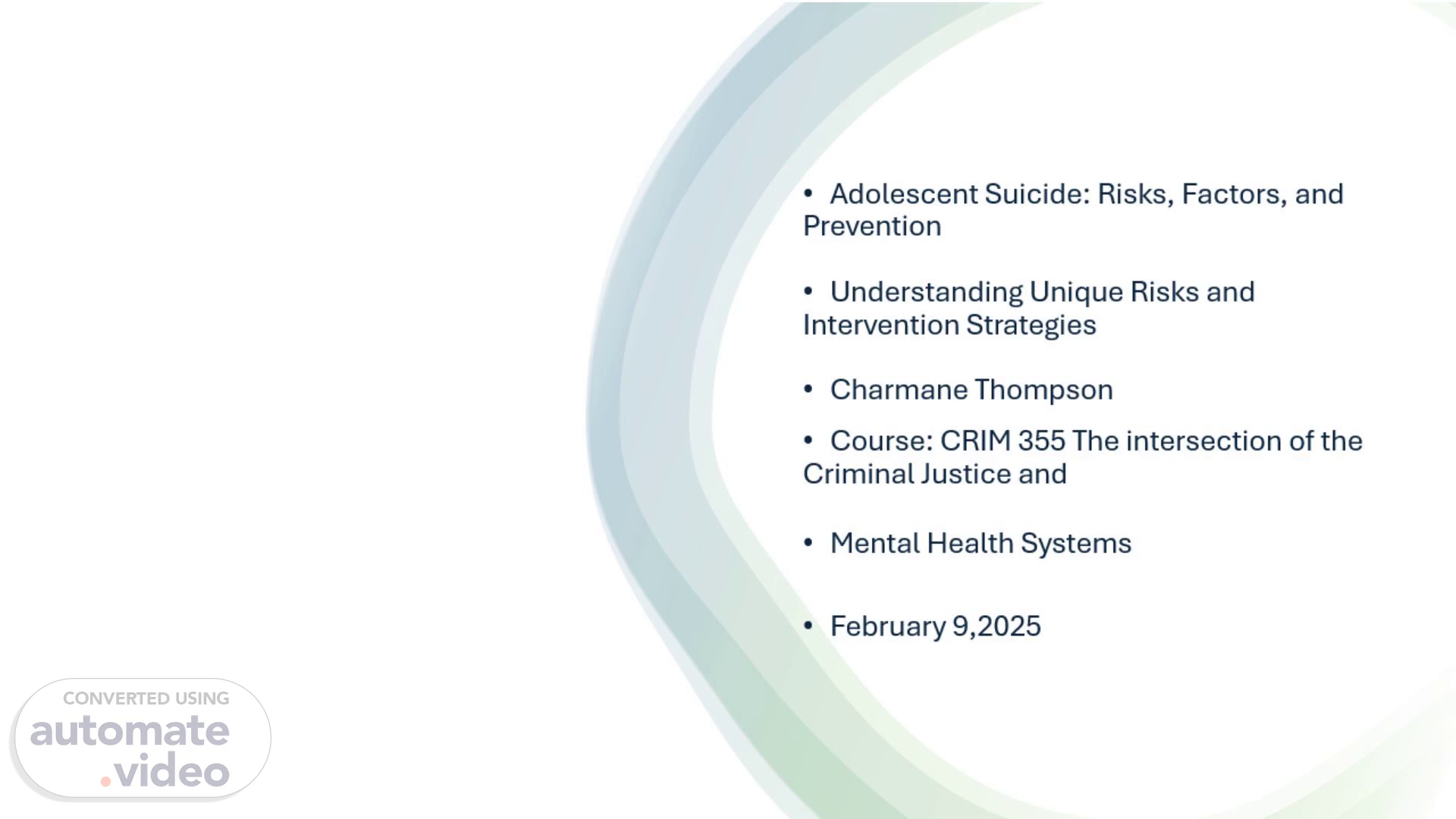Scene 1 (0s)
Adolescent Suicide: Risks, Factors, and Prevention Understanding Unique Risks and Intervention Strategies Charmane Thompson Course: CRIM 355 The intersection of the Criminal Justice and Mental Health Systems February 9,2025.
Scene 2 (12s)
Introduction. Suicide is a leading cause of death among adolescents. Understanding specific risks and factors helps in prevention. This presentation focuses on the unique risks associated with adolescent suicide.
Scene 3 (24s)
Epidemiology of Adolescent Suicide. Suicide is the second leading cause of death in individuals aged 10–24. Adolescents have higher rates of suicidal ideation compared to other age groups. Males are more likely to complete suicide, while females report higher rates of suicidal ideation (Adolescent Suicide—Understanding Unique Risks and Prevention Strategies)..
Scene 4 (41s)
Risk Factors for Adolescent Suicide. Mental health disorders (depression, anxiety, PTSD) Previous suicide attempts Family history of suicide Substance abuse Social isolation and bullying (Suicide and Suicide Risk in Adolescents).
Scene 5 (53s)
The Role of Sexual Abuse and Other Factors. Adolescents who have experienced physical or sexual abuse are at a significantly higher risk. Parental abuse and lack of open communication increase suicidal thoughts. School attendance and social support can mitigate risks (Suicidal Ideation Among Adolescents—The Role of Sexual Abuse and Other Factors)..
Scene 6 (1m 10s)
Signs and Symptoms of Suicidal Ideation. Withdrawal from family and friends Expressing feelings of hopelessness or worthlessness Increased risk-taking behaviors Changes in sleep and eating patterns Giving away personal belongings (Adolescent Suicide—Understanding Unique Risks and Prevention Strategies).
Scene 7 (1m 23s)
Prevention Strategies and Intervention. Early identification through screening in schools and trauma centers. Increasing access to mental health resources. Encouraging open communication between adolescents and caregivers. Training educators and healthcare providers to recognize warning signs (Suicide and Suicide Risk in Adolescents)..
Scene 8 (1m 38s)
Suicide Prevention in Schools and Communities. Implementing school-based mental health programs. Reducing the stigma surrounding mental health issues. Encouraging peer support and mentorship programs. Crisis intervention hotlines and counseling services (Suicidal Ideation Among Adolescents—The Role of Sexual Abuse and Other Factors)..
Scene 9 (1m 55s)
Conclusion. Adolescent suicide is a complex issue with multiple risk factors. Prevention requires a multi-faceted approach involving families, schools, and healthcare providers. Recognizing warning signs and promoting early intervention can save lives..
Scene 10 (2m 8s)
References. Adolescent Suicide—Understanding Unique Risks and Prevention Strategies. https://pmc.ncbi.nlm.nih.gov/articles/PMC8976221/?utm_source Suicidal Ideation Among Adolescents—The Role of Sexual Abuse and Other Factors. https://pmc.ncbi.nlm.nih.gov/articles/PMC8722622/?utm_source Suicide and Suicide Risk in Adolescents. https://publications.aap.org/pediatrics/article/153/1/e2023064800/196189/Suicide-and-Suicide-Risk-in-Adolescents?utm_source.
